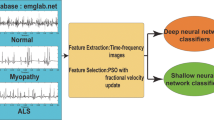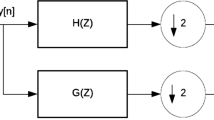Abstract
The recorded electrical activity associated with muscles and nerves are called electromyograms (EMG) and are useful for examination of disorders in the muscle and nerve systems. The efficient discrimination of normal and abnormal EMG signals play vital role in the automated diagnostic assistance tools. Hence, the proper extraction of feature subset, selection of best feature subset and development of classifier model were essential to differentiate the abnormal and normal signals. In this paper, a total of 80 time–frequency features of normal, myopathy and Amyotrophic Lateral Sclerosis (ALS) EMG signals were extricated using four different transformation approach namely Stockwell, Synchro-Extracting, Wigner–Ville and Short-TIme Fourier Transform. The selection of 15 significant features was performed using Genetic Algorithm (GA). Also, the statistical significance of the selected features were analyzed using three different classification models of normal, myopathy, ALS cases. Further, the artificial neural network (ANN) classifiers were developed individually for extracted transformed time–frequency features and GA selected features. Results demonstrated that the selected features by genetic algorithm are efficient for the design of EMG classifiers.








Similar content being viewed by others
References
Begg R, Lai DT, Palaniswami M (2007) Computational intelligence in biomedical engineering. CRC Press, Boca Raton
Blottner D, Salanova M (2015) Neuromuscular System. In: The neuromuscular system: from earth to space life science. Springer, Cham, pp 63–87
Christodoulou CI, Pattichis CS (1999) Unsupervised pattern recognition for the classification of EMG signals. IEEE Trans Biomed Eng 46(2):169–178
Domingo-Horne RM, Salajegheh MK (2017) An approach to myopathy for the primary care clinician. Am J Med 131:237–243
Landfeldt E, Edström J, Lindgren P, Lochmüller H (2017) Patient preferences for treatments of neuromuscular diseases: a systematic literature review. J Neuromuscul Dis 4(4):285–292
Alim OA, Moselhy M, Mroueh F (2012) EMG signal processing and diagnostic of muscle diseases. In: Advances in computational tools for engineering applications (ACTEA), 2012 2nd international conference on, IEEE, pp 1–6
Subasi A (2013) Classification of EMG signals using PSO optimized SVM for diagnosis of neuromuscular disorders. Comput Biol Med 43(5):576–586
Oskoei MA, Hu H (2008) Support vector machine-based classification scheme for myoelectric control applied to upper limb. IEEE Trans Biomed Eng 55(8):1956–1965
Boashash B (1991) Time–frequency signal analysis. Prentice Hall, Upper Saddle River
Davies MR, Reisman SS (1994) Time frequency analysis of the electromyogram during fatigue. In: Bioengineering conference, 1994, proceedings of the 1994 20th annual northeast, IEEE, pp 93–95
Bajaj V, Rai K, Kumar A, Sharma D (2017) Time-frequency image based features for classification of epileptic seizures from EEG signals. Biomed Phys Eng Express 3(1):015012
Zhang Y, Li P, Zhu X, Su SW, Guo Q, Xu P, Yao D (2017) Extracting time-frequency feature of single-channel vastus medialis EMG signals for knee exercise pattern recognition. PLoS One 12(7):e0180526
Englehart K, Hudgins B, Parker PA, Stevenson M (1999) Classification of the myoelectric signal using time–frequency based representations. Med Eng Phys 21(6):431–438
Zawawi TT, Abdullah AR, Shair EF, Halim I, Rawaida O (2013) Electromyography signal analysis using spectrogram. In: Research and development (SCOReD), 2013 IEEE student conference on, IEEE, pp 319–324
Stockwell RG (2007) A basis for efficient representation of the S-transform. Digit Signal Proc 17(1):371–393
Ji Y, Xie HB (2018) Myoelectric signal classification based on S transform and two-directional two-dimensional principal component analysis. Trans Inst Meas Control 40(7):2387–2395
Bigliassi M, Scalassara PR, Kanthack TFD, Abrão T, de Moraes AC, Altimari LR (2014) Fourier and wavelet spectral analysis of EMG signals in 1-km cycling time-trial. Appl Math 5(13):1878
Samuel OW, Zhou H, Li X, Wang H, Zhang H, Sangaiah AK, Li G (2018) Pattern recognition of electromyography signals based on novel time domain features for amputees’ limb motion classification. Comput Electr Eng 67:646–655
McCool P, Petropoulakis L, Soraghan JJ, Chatlani N (2015) Improved pattern recognition classification accuracy for surface myoelectric signals using spectral enhancement. Biomed Signal Process Control 18:61–68
Mur A, Dormido R, Vega J, Dormido-Canto S, Duro N (2016) Unsupervised event detection and classification of multichannel signals. Expert Syst Appl 54:294–303
Krishnamurthy K, Ponnuswamy MJ (2018) Coupling of optimization algorithms based on swarm intelligence: an application for control of heroin addiction epidemic. In: Nature-inspired intelligent techniques for solving biomedical engineering problems. IGI Global, Hershey, pp 27–50
Rajinikanth V, Raja NSM, Kamalanand K (2017) Firefly algorithm assisted segmentation of tumor from brain MRI using Tsallis function and Markov random field. J Control Eng Appl Inform 19(3):97–106
Manickavasagam K, Sutha S, Kamalanand K (2014) An automated system based on 2 d empirical mode decomposition and k-means clustering for classification of Plasmodium species in thin blood smear images. BMC Infect Dis 14(3):P13
Manickavasagam K, Sutha S, Kamalanand K (2014) Development of systems for classification of different plasmodium species in thin blood smear microscopic images. J Adv Microsc Res 9(2):86–92
Kamalanand K, Jawahar PM (2013) Resource limited estimation of HIV-1 viral load from CD4 cell count using coupled bacterial foraging/jumping frogs algorithm. World Allergy Organ J 6:189
Kamalanand K, Jawahar PM (2012) Coupled jumping frogs/particle swarm optimization for estimating the parameters of three dimensional HIV model. BMC Infect Dis 12(1):P82
Kamalanand K, Jawahar PM (2015) Prediction of human immunodeficiency virus-1 viral load from CD4 cell count using artificial neural networks. J Med Imaging Health Inform 5(3):641–646
Kamalanand K, Mannar Jawahar P (2016) Comparison of particle swarm and bacterial foraging optimization algorithms for therapy planning in HIV/AIDS patients. Int J Biomath 9(02):1650024
Nikolic M (2001) Detailed analysis of clinical electromyography signals EMG decomposition, findings and firing pattern analysis in controls and patients with myopathy and amyotrophic lateral sclerosis. PhD thesis, Faculty of Health Science, University of Copenhagen. The data are available as dataset N2001 at http://www.emglab.net
Zhang X, Cui J, Wang W, Lin C (2017) A study for texture feature extraction of high-resolution satellite images based on a direction measure and gray level co-occurrence matrix fusion algorithm. Sensors 17(7):1474
Phinyomark A, Phukpattaranont P, Limsakul C (2012) Feature reduction and selection for EMG signal classification. Expert Syst Appl 39(8):7420–7431
Huang CL, Wang CJ (2006) A GA-based feature selection and parameters optimizationfor support vector machines. Expert Syst Appl 31(2):231–240
Yang J, Honavar V (1998) Feature subset selection using a genetic algorithm. In: Feature extraction, construction and selection. Springer, Boston, pp 117–136
Ambikapathy B, Krishnamurthy K (2018) Analysis of electromyograms recorded using invasive and noninvasive electrodes: a study based on entropy and Lyapunov exponents estimated using artificial neural networks. J Ambient Intell Humaniz Comput 1–9
Author information
Authors and Affiliations
Corresponding author
Additional information
Publisher’s Note
Springer Nature remains neutral with regard to jurisdictional claims in published maps and institutional affiliations.
Rights and permissions
About this article
Cite this article
Ambikapathy, B., Kirshnamurthy, K. & Venkatesan, R. Assessment of electromyograms using genetic algorithm and artificial neural networks. Evol. Intel. 14, 261–271 (2021). https://doi.org/10.1007/s12065-018-0174-0
Received:
Revised:
Accepted:
Published:
Issue Date:
DOI: https://doi.org/10.1007/s12065-018-0174-0




